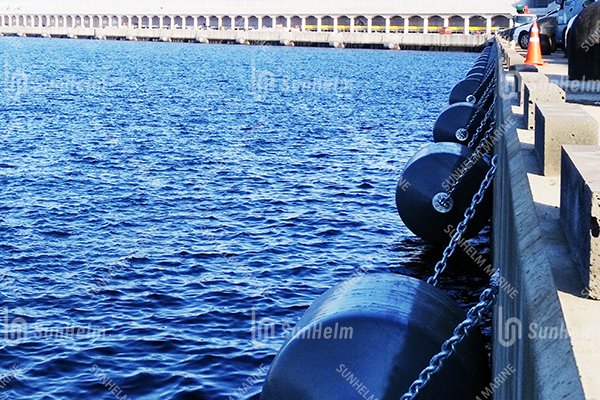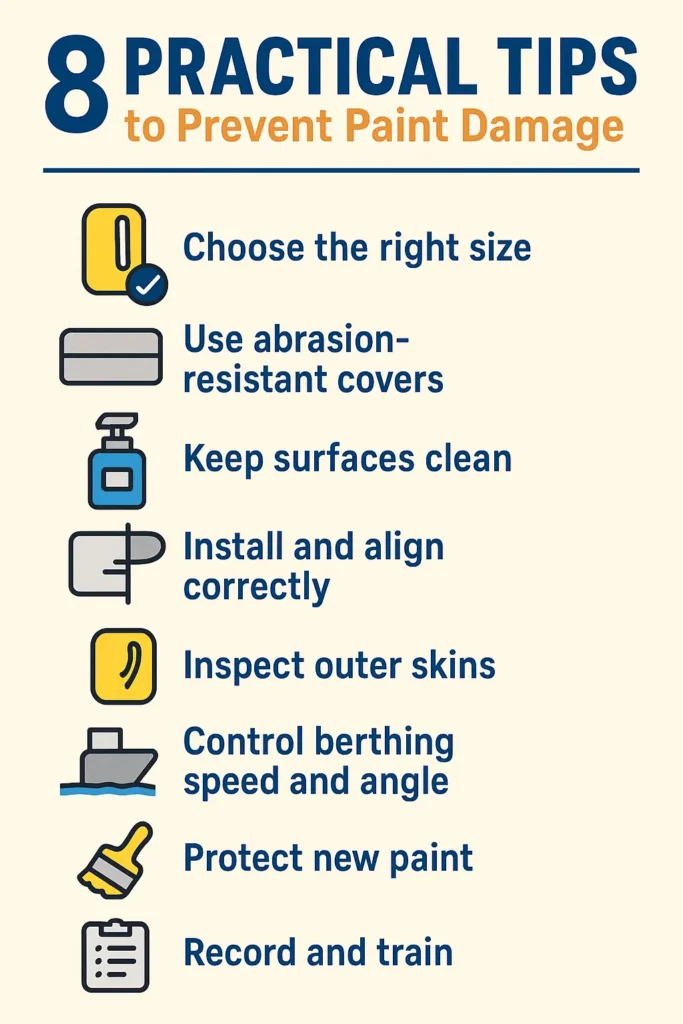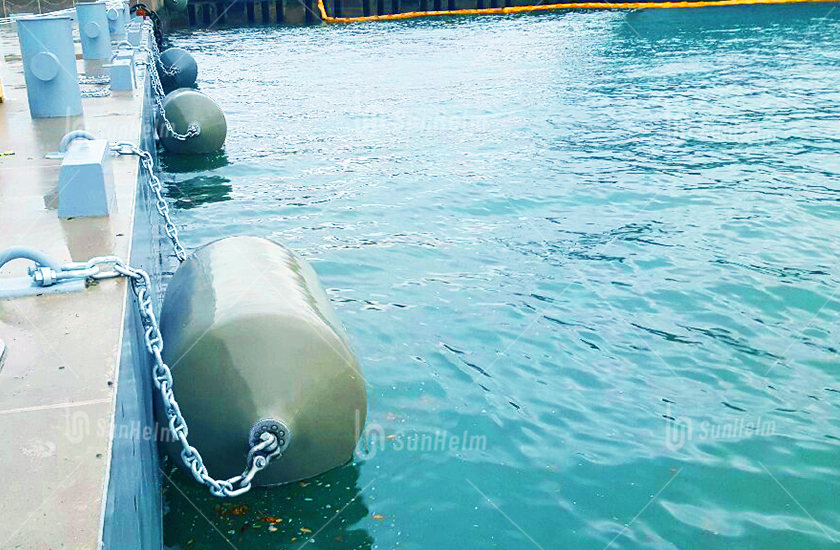Introduction
Do foam fenders damage ship paint? In most cases, foam fenders are designed to protect your vessel — not harm it. Still, certain conditions like trapped grit, worn-out outer layers, or poor installation can lead to scratches or stains. In this guide, Sunhelmmarine explains why this happens, when it’s most likely, and how to stop it before it starts. Whether you’re a shipowner, port operator, or marine engineer, you’ll get clear, practical tips to keep your hull looking fresh.
1. What Are Foam Fenders?
Foam fenders are impact-absorbing devices made with a resilient foam core wrapped in a tough outer skin — often polyurethane, reinforced elastomer, or other synthetic materials. They’re designed to absorb berthing energy while minimizing rebound force.
Compared to pneumatic fenders, foam fenders require less maintenance, are puncture-resistant, and provide a wide contact surface. At Sunhelmmarine, we manufacture foam fenders in various sizes, shapes, and coatings to suit everything from small fishing vessels to large container ships.

2. How Ship Paint Gets Damaged
Hull paint damage is not always about the fender itself — it’s often about what happens between the fender and the ship. Here are the main culprits:
- Abrasion from movement – If the ship shifts during berthing, continuous rubbing can wear away paint over time.
- Grit and debris – Sand, rust flakes, or small stones trapped between the fender and hull can act like sandpaper.
- Material transfer – Some outer skins, especially aged rubber, can leave black marks or stains.
- Edge pressure – Improperly sized fenders or incorrect positioning can focus force on a small area.
- Old or weak paint layers – Older coatings, or paints not designed for marine abrasion, are more vulnerable.
In short: the risk is a mix of environmental conditions, vessel handling, and maintenance habits.
3. Why Foam Fenders Can Help Protect Paint
When used correctly, foam fenders actually reduce the risk of paint damage compared to some other fender types.
Here’s why:
- Wide contact area spreads impact force evenly.
- Energy absorption prevents hard jolts.
- Custom coatings (like Sunhelmmarine’s wear-resistant skins) minimize surface friction.
- No internal pressure loss means consistent performance without sudden “flat spots” that can concentrate stress.
4. Situations Where Foam Fenders Might Damage Paint
Even the best fender can cause cosmetic issues under certain conditions:
- Berthing against dirty or gritty fender surfaces.
- High-speed approaches that create strong lateral sliding.
- Using damaged fenders with exposed foam core.
- Wrong size or type for vessel hull shape.
- Long-term neglect without cleaning or rotation.
The good news? All of these can be avoided with proper care and planning.
5. 8 Practical Tips to Prevent Paint Damage
- Choose the right size – Match fender size and compression rating to vessel displacement and docking energy.
- Use abrasion-resistant covers – Add UHMW-PE panels or protective sleeves for high-wear docks.
- Keep surfaces clean – Regularly wash away sand, mud, or barnacle growth.
- Install and align correctly – Ensure even hull contact without sharp edge points.
- Inspect outer skins – Repair or replace at the first sign of cracks, cuts, or punctures.
- Control berthing speed and angle – Good seamanship is the first line of defense.
- Protect new paint – Use temporary soft pads during the first weeks after repainting.
- Record and train – Keep a maintenance log and train crew in fender care.

At Sunhelmmarine, we design our foam fenders with these principles in mind, offering customization to match your exact needs.
6. Quick Inspection & Cleaning Guide
| Frequency | What to Check | Action |
|---|---|---|
| Daily | Visible dirt, grit, marine growth | Rinse with fresh water |
| Weekly | Outer skin surface | Wipe clean with mild detergent |
| Monthly | Mounting, alignment | Adjust if misaligned |
| Annually | Compression performance, internal condition | Schedule professional check |
7. How to Fix Existing Scuff Marks
If you notice black streaks or light scratches:
- Rinse the area with fresh water.
- Use a soft sponge and marine-safe cleaner.
- For stubborn marks, apply a non-abrasive rubbing compound.
- Test any cleaner on a small area first.
- If paint is damaged, schedule a touch-up with marine-grade paint.
Conclusion
Foam fenders aren’t your enemy — they’re one of the best ways to shield your hull from docking impacts. With smart selection, proper installation, and simple maintenance, you can keep both your vessel and its paint job in top shape.
Sunhelmmarine is here to help you choose the right fender system, with customization, expert advice, and after-sales support.
FAQs
Q1: Do foam fenders leave black marks?
Sometimes, but it’s usually just surface transfer from the fender skin and can be cleaned off easily.
Q2: Can foam fenders be used with freshly painted hulls?
Yes, but we recommend using extra soft covers during the first few weeks.
Q3: Which is better for paint protection: foam or pneumatic fenders?
Both can work well — it depends on vessel type, berthing conditions, and maintenance practices.
Q4: Does Sunhelmmarine offer anti-abrasion coatings?
Yes. We provide multiple outer skin options including UHMW-PE panels and reinforced elastomers.


